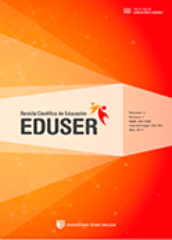Virtual environments for learning and written expression: a preliminary study
DOI:
https://doi.org/10.18050/eduser.v7i2.2663Keywords:
Adequacy of the text, Coherence of the text, Cohesion of the text, Communicative interaction, School writing, Virtual learning environments, Written expression, Writing evaluation, Writing on virtual platformsAbstract
Virtual learning environments (VLE) structure written learning through routes provided by virtual guides or teachers, this being a strict measure for interoperability with study participants. However, little is known about its interactive functionality among the participants who communicate on the platforms that configure these environments, for which, we investigated the effects that the VAS produced in the written expression of 30 subjects of secondary education in the capital of Peru. We design a research with a quantitative approach of a pre-experimental type, in which we use qualification sheets of the written production. The results report that the subjects participating in the experiment developed the capacity for written expression. This effect was developed in the largest number of subjects, who demonstrated improvements in the dimension of text adaptation and continuous evaluation of writing. The events witnessed allow us to argue that virtual learning environments grant freedom for creativity in writing, which has regulated in students the ability to write through social interactions exercised on the platforms in which they participated.
Downloads
Additional Files
Published
How to Cite
Issue
Section
License

This work is licensed under a Creative Commons Attribution-NonCommercial-NoDerivatives 4.0 International License.













